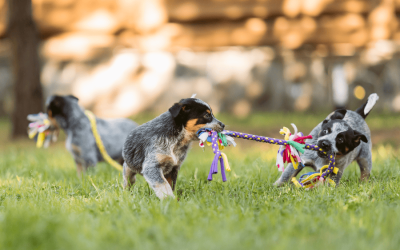Spring 2024 is upon us, which means it’s time to review some important pet safety tips. From potential hazards in the garden to pesky pests and common springtime cleaning chemicals, there are plenty of dangers to both dogs and cats for us humans to be aware of.
So as the warmer months roll in, so do the reasons to be proactive when it comes to pet care. Spring safety for pets involves keeping your pets safe both indoors and out, protecting them from dangers that are man-made as well as naturally occurring.
Below, we’ve outlined ten key tips to help you identify potential pet concerns as you spring into the new season.
1. Use pet-friendly cleaning supplies
Spring cleaning is common practice this time of year, but have you checked to make sure you’re keeping pets safe in the process? Many common household cleaning products can be toxic to pets, whether ingested or simply touched by paws. Soaps, bleach, polishes, and cleaners can all irritate your pet’s skin and damage their gastrointestinal tract. Cleaning supplies, like a sponge or pipe cleaner, can also present problems when ingested by a curious pet.
To thwart troubles before they start, opt for pet-safe cleaning supplies wherever possible, and store unsafe chemicals out of paws’ reach. As a rule of thumb, keep your pet away from where you’re cleaning, and wait for all surfaces to dry thoroughly before letting them back into the space.
2. Play it safe with plants
One of the first steps of ensuring spring safety for pets is knowing which plants are pet friendly. Most pet owners know certain plants are poisonous to pets but even your pet-safe blossoms can be troublesome if ingested by dogs and cats. Large leaves and stems (especially those with thorns!) can lead to choking and damage along the intestinal tract.
Bone meal is often used as a fertilizer or supplement when planting bulbs, all of which can be attractive to canines. Eating both the bulb and the bone meal can make for a very sick dog. If you dilute most fertilizers with plenty of dirt or water, it’s often safe to use around pets (unless you have a small dog). Cat lovers, remember that lilies can cause kidney failure in felines if ingested.
Love plants but have a cat who just can’t keep their paws off? Learn what plants are safe for cats at home.
3. Secure your window screens
It’s that time of year when you can finally open your windows to experience warmer, breezier days. Keep in mind, after the long winter months, you won’t be the only one welcoming sunshine and warmth. Your pet may be just as eager, and the fresh scents from outdoors this time of year could make them extra curious.
As you open windows, make sure your furry friends aren’t at risk of sneaking out or falling. Install sturdy screens with a snug fit and supervise your pets around any open windows.
4. Avoid using slug bait
As you’re prepping your garden, it can be tempting to use slug bait (depending on where you live) to keep it protected. But as destructive to plants as these slimy critters can be, the products used to stop them can be highly hazardous to your pet’s health. The toxins in typical slug bait are often mixed with sugars to attract the slugs, but it also entices pets. Even a small amount can be fatal, so ask your veterinarian about pet-safe slug control options. At the end of the day, you may just want to install a deep fence around gardens to keep both pests and pets out.
5. Avoid newly fertilized grass (for at least 24 hours)
Now that it’s warmer out, it’s time to show off that beautiful green lawn! Unfortunately, having the greenest grass on the block can mean using fertilizer that is poisonous and potentially fatal to pets.
Keep your furry friend off the grass and away from any treated areas for at least 24 hours or opt for pet-safe products. Be cautious of organic fertilizer too — its captivating scent might tempt your dog to make a meal out of manure.
6. Keep an eye out for foxtails
It’s that time of year again: foxtail season. Foxtails, or grass awns, are a type of tall grass with elongated, bristly spikes at the ends of each blade somewhat resembling a fox’s tail. It’s these ends that can sneak up on your pet and cause serious problems. Once they embed in your pet’s fur, they can cause serious damage like ruptured eardrums and infections.
Prevent foxtail problems by regularly examining your pet’s coat (and nose!) after they’ve spent time outside. It’s also a good idea to avoid patches of longer grass, and never allow pets to stay outdoors on their own.
7. Shed winter weight
It’s hard to keep up on exercise when it’s cold out, but staying cozy inside can lead to extra winter weight on your pet. Just like humans, overweight pets are more likely to develop serious conditions like diabetes, respiratory and heart diseases, and joint problems.
Check with your veterinarian if you suspect your pet has gained weight. They can confirm whether or not your pet’s weight is within a healthy range. If it isn’t, they can help you create a weight loss plan, which may simply include more exercise and watching food portions.
8. Protect against parasites
Warmer weather in spring often leads to an increase in the population of fleas, ticks, and other parasites. These parasites not only cause discomfort to pets but can also transmit potentially serious diseases.
Both dogs and cats at risk of fleas and ticks, as these tiny insects can make their way inside and onto your pet’s fur via open doors and windows, shoes, and human clothing. Because they can carry a variety of illnesses (including invasive parasites), practicing monthly flea and tick control is crucial to your pet’s well-being. Talk with your veterinarian about what options may be best for your pet.





0 Comments